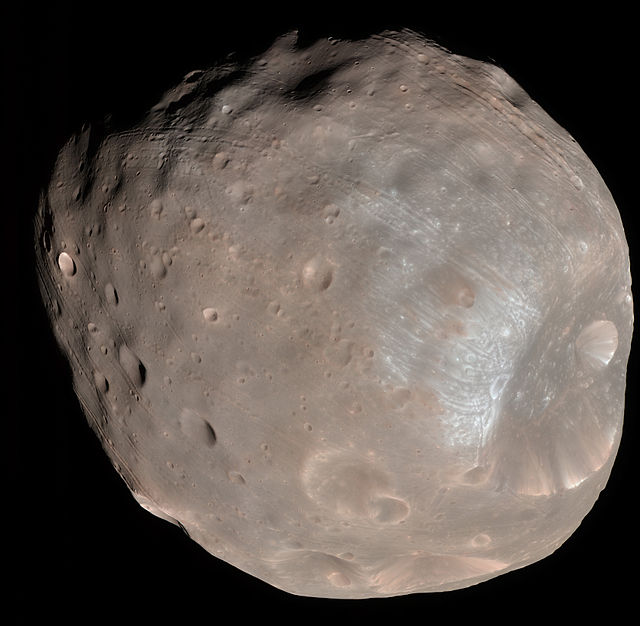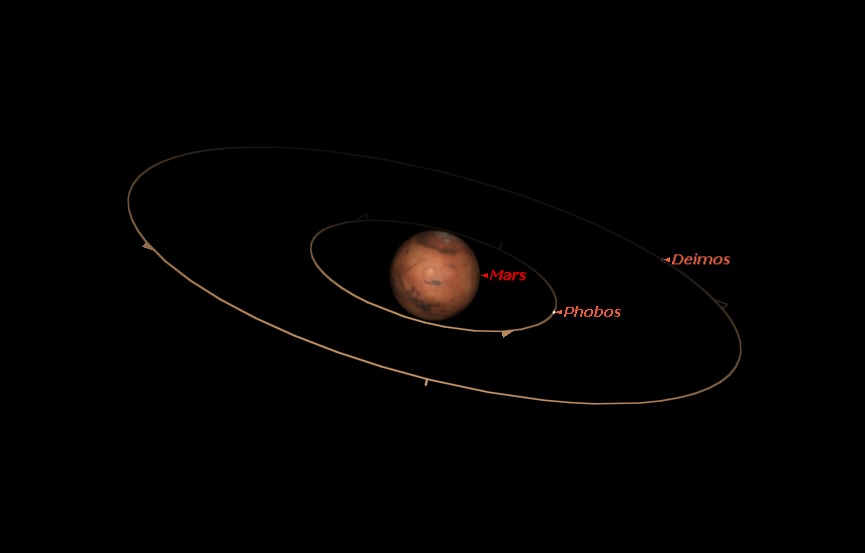Mars has two moons, Phobos and Deimos, which are thought to be captured asteroids. Both satellites were discovered in 1877 by Asaph Hall and are named after the characters Phobos (panic/fear) and Deimos (terror/dread) who, in Greek mythology, accompanied their father Ares, god of war, into battle. Ares was known as Mars to the Romans. It is possible that Mars may have moons smaller than 50–100 meters and a dust ring between Phobos and Deimos may be present but none has been discovered.

Phobos (systematic designation: Mars I) is the larger and closer of the two natural satellites of Mars. Both moons were discovered in 1877.
A small, irregularly shaped object with a mean radius of 11 km, Phobos is seven times more massive than Mars’s outer moon, Deimos. Phobos is named after the Greek god Phobos, a son of Ares (Mars) and Aphrodite (Venus) which was the personification of Horror. The name “Phobos” is pronounced /ˈfoʊbəs/ FOH-bəs, or like the Greek Φόβος.
Phobos orbits 6,000 km (3,700 mi) from the Martian surface, closer to its primary than any other known planetary moon. It is so close that it orbits Mars faster than Mars rotates, and completes an orbit in just 7 hours and 39 minutes. As a result, from the surface of Mars it appears to rise in the west, move across the sky in 4 hours 15 min or less, and set in the east, twice each Martian day. Due to tidal interactions, Phobos is drawing closer to Mars by one meter every century, and it is predicted that in 50 million years it will collide with the planet or break up into a planetary ring.
Phobos is one of the least reflective bodies in the Solar System, and features a large impact crater, Stickney. The temperatures range from about −4 °C (25 °F) to −112 °C (−170 °F), on the sunlit and shadowed sides respectively.

Deimos (systematic designation: Mars II) is the smaller and outermore of the two natural satellites of the planet Mars with a mean radius of 6.2 km, the other being Phobos. Deimos takes 30.3 hours to orbit Mars. The name “Deimos” is pronounced /ˈdaɪməs/ DY-məs, or sometimes /ˈdiːməs/ DEE-məs or like the Greek Δείμος. In Greek mythology, Deimos was the twin brother of Phobos and personified Terror.
Deimos, like Mars’s other moon, Phobos, has spectra, albedos and densities similar to those of a C- or D-type asteroid. Like most bodies of its size, Deimos is highly non-spherical with triaxial dimensions of 15 × 12.2 × 11 km making it 0.56 times the size of Phobos. Deimos is composed of rock rich in carbonaceous material, much like C-type asteroids and carbonaceous chondrite meteorites. It is cratered, but the surface is noticeably smoother than that of Phobos, caused by the partial filling of craters with regolith. The regolith is highly porous and has a radar-estimated density of only 1.471 g/cm3. The two largest craters, Swift and Voltaire, each measure about 3 km (1.9 mi) across.
It has an escape velocity of 5.6 m/s and apparent magnitude of 12.45.
